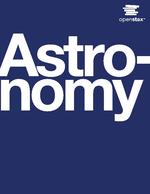|
|

Notes
- Summary:
- Astronomy is designed to meet the scope and sequence requirements of one- or two-semester introductory astronomy courses. The book begins with relevant scientific fundamentals and progresses through an exploration of the solar system, stars, galaxies, and cosmology. The Astronomy textbook builds student understanding through the use of relevant analogies, clear and non-technical explanations, and rich illustrations. Mathematics is included in a flexible manner to meet the needs of individual instructors. - Open Stax ( ,, )
- Scope and Content:
- Preface
1. Science and the Universe: A Brief Tour
2. Observing the Sky: The Birth of Astronomy
3. Orbits and Gravity
4. Earth, Moon, and Sky
5. Radiation and Spectra
6. Astronomical Instruments
7. Other Worlds: An Introduction to the Solar System
8. Earth as a Planet
9. Cratered Worlds
10. Earthlike Planets: Venus and Mars
11. The Giant Planets
12. Rings, Moons, and Pluto
13. Comets and Asteroids: Debris of the Solar System
14. Cosmic Samples and the Origin of the Solar System
15. The Sun: A Garden-Variety Star
16. The Sun: A Nuclear Powerhouse
17. Analyzing Starlight
18. The Stars: A Celestial Census
19. Celestial Distances
20. Between the Stars: Gas and Dust in Space
21. The Birth of Stars and the Discovery of Planets outside the Solar System
22. Stars from Adolescence to Old Age
23. The Death of Stars
24. Black Holes and Curved Spacetime
25. The Milky Way Galaxy
26. Galaxies
27. Active Galaxies, Quasars, and Supermassive Black Holes
28. The Evolution and Distribution of Galaxies
29. The Big Bang
30. Life in the Universe
How to Study for an Introductory Astronomy Class
Astronomy Websites, Images, and Apps
Scientific Notation
Units Used in Science
Some Useful Constants for Astronomy
Physical and Orbital Data for the Planets
Selected Moons of the Planets
Future Total Eclipses
The Nearest Stars, Brown Dwarfs, and White Dwarfs
The Brightest Twenty Stars
The Chemical Elements
The Constellations
Star Chart and Sky Event Resources
Index
- Preferred Citation:
- Fraknoi, A., Morrison, D., & Wolff, S. C. (2016). Astronomy. OpenStax. http://open-nj.sobeklibrary.com/AA00001323. CC BY 3.0 license.
Record Information
- Source Institution:
- Rice University
- Holding Location:
- OpenStax
- Rights Management:
 This item is licensed with the Creative Commons Attribution License. This license lets others distribute, remix, tweak, and build upon this work, even commercially, as long as they credit the author for the original creation. This item is licensed with the Creative Commons Attribution License. This license lets others distribute, remix, tweak, and build upon this work, even commercially, as long as they credit the author for the original creation.
|
|